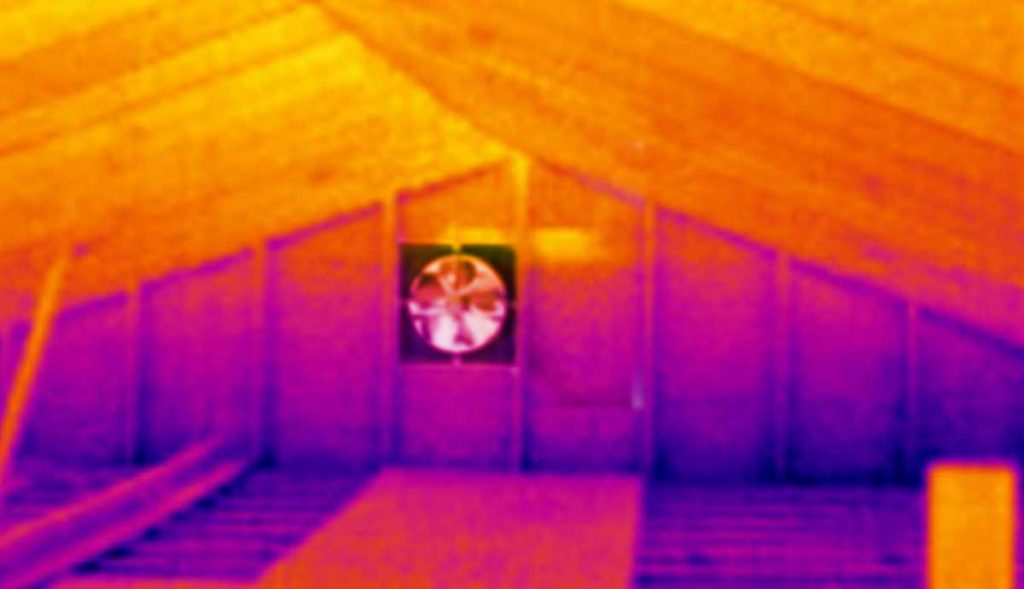If you consider adding an attic fan to your home, it is essential to understand how it works. No one would like to commit to a home renovation or addition that they are unsure how it operates. Here is a comprehensive guide on how attic fans work.
Components of an Attic Fan
It is essential to understand the elements of a solar attic fan before diving into how an attic fan works. The following are the components of an attic fan:
Thermostat
A significant percentage of attic fans use a simple thermostat that appears like a small metal box. The thermostat is attached to the truss within a short distance, a maximum of two feet from the fan.
The thermostat features a temperature dial. You set your desired temperature on the thermostat, beyond which the fan will turn out automatically. Then, the attic fan will automatically turn off if the temperature drops below the set figure.
An inbuilt thermostat means you don’t need to keep climbing to the attic to ensure the temperature around the house is optimized.
Timer
An attic fan works similarly to a bathroom exhaust fan. You can wire an attic fan to a timer to automate the turning on the process. For example, you can set a timer for 9:00 am to 4:00 pm, during which the attic fan will be running.
Wall switch
If you want to turn your attic fan on and off like the lights, you can add a wall switch. However, the switch should be installed next to the hatch.
How Does an Attic Fan Work?

Most attic fans rely on electricity as the source of power, although there have been solar-powered attic fans in the past decade. Attic fans are installed on gable walls or roofs to help exhaust hot attic air from the house outside.
The primary role of an attic fan is to remove hot air from your attic through soffit vents that are pre-installed in the eaves. Attics will always be the hottest space in a house as the sun hits the roofing sheets. However, when too much heat in the attic, it can begin seeping down to other rooms.
The role of the attic fan is to prevent the accumulation of this heat, thus, ensuring the heat doesn’t spread into other rooms. Although the attic is pre-designed to expel hot air and replace it with cool air, the fan speeds up the system.
Attic fans draw in fresh air from the environment to get rid of the hot, stagnant air from the attic. The fans draw in fresh air using passive vents located in the attic such as:
- Turtle vents- they can be rectangular or triangular. Turtle vents are smaller and more frequent. You will find them spaced out on the roof.
- Soffit vents are the most common vents, and they tend to be continuous. The vent holes are quite small and appear like a white mesh.
- Gable vents- a home usually has two gable vents, one placed on each side. They are considerably massive and rectangular.
What You Need to Know About an Attic Fan
You might need more than one.
Sometimes, you might need several fans depending on the size of your attic, the climate in your area, among other factors.
Seals increase the effectiveness of attic fans.
Like AC units, attic fans will work properly if there are seals. Let us take an example of AC units. You won’t turn on your air conditioning unit to keep you warm if the windows are closed, right?
Similarly, the space between the attic, the roof, and other rooms needs to be sealed. Any chipping of the seal will hinder, and the result will be an overworked machine.
It doesn’t need to be on throughout.
Unlike other fans around the house, the attic fan shouldn’t be running throughout. The role of the attic fan is to cool the attic, especially during summer. Therefore, you can reduce expenses by using it sparingly during cold weather.
In cold weather, attic fans help eliminate moisture which could build up and cause mold growth. However, they don’t need to run all day every day to achieve this.
The fan works optimally with the proper flow of air
Airflow is a critical consideration when cooling the attic. Anything, no matter how little that restricts airflow, will limit the fan’s effectiveness. Lack of proper airflow means the hot air will easily get trapped.
Therefore, the fan will need to work twice as hard to expel the hot air. The extra vigilance of the fan could result in wasted energy and surprisingly high electricity bills.
The size of the fan is immaterial.
As you can see in the install video above, the size of the fan does not matter. You don’t need a huge fan to keep the hot air out. A large fan typically means it can reach more air. However, the size of the fan does not matter. Instead of opting for a large fan, consider getting a more powerful and effective one.
Final Words
Now that you understand the components of attic fans and how they work, let us look at what they can do for your home;
First, they can increase the HVAC efficiency by reducing the load on your conditioner. They have proven to be more energy-efficient than traditional fans. Second, they offer roof protection. If you have an asphalt roof, you need to ensure your attic is cool to ensure durability. Lastly, the fans help prevent mold growth which is common when moisture is accumulated in the attic.










My landlady installed an attic fan. I rent a bedroom in the back of the house. Instead of helping keep this back room cool, the attic fan appears to draw outside air in through the windows and the room gets hotter in summer when the attic fan runs. I have a room AC that works harder instead of less now that the attic fan runs. The house was built in the 1970s and no insulation is between the outside walls of the house and the back and closet walls in the bedroom. Plus this side of the house faces West and gets the full brunt of the sun during summer and all sunsets. During California’s triple-digit ordeal in August my back wall reached 90 degrees when it was 113 outside. I also feel hot air running through my room when my sliding glass door is closed (the only outside window). I keep the AC running at 66 degrees, but on hot days the coolest my room reaches is about 70-72. The landlady runs her AC at 78. I keep ceiling vents closed or at a minimum to prevent the clash between my AC temp and hers.
Her home stays relatively cool (76 is cold for her) when the attic fan runs. While my room is lucky to stay at 70 in summer. I have medical conditions that require cooler temperatures. I got ill during out hot spell because I couldn’t cool down. When I make dinner in the kitchen I end up soaking wet in sweat and have to change clothes and stay in my room to cool down.
Is her attic fan working properly if my room constantly remains hot and seems hotter when the attic fan runs? I fear my room AC will break down from working so hard to overcome the constant heat in this room. Can anything be done?